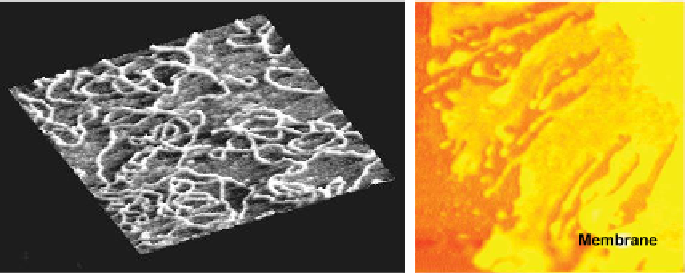Biology Reference
In-Depth Information
One of the major obstacles that have restricted the use of NSOM in cell
biology has been related to its dificulty to operate in liquid conditions, a
crucial step towards live cell imaging. Successful control of the tip-sample
distance has been routinely achieved in air by using tuning forks as sensing
elements and driven at resonance, as explained earlier. However, this
approach systematically failed once the tuning fork was immersed in a liquid.
Our group has demonstrated that, in aqueous environments, sensitivity of the
surface topography can be regained by keeping the tuning fork dry in a “diving
bell” enclosure just above the probe.
39,40
Using this system, we have been able
to measure the topology of intact cell membranes without compromising
used the tuning fork with the tip placed perpendicular to the prongs of the
fork and protruding about ~2 mm below the fork. The coniguration works
thus as “tapping mode” with the tip immersed in solution and the tuning fork
kept dry above the liquid.
41
An alternative method for position control is based
on ion conductance. The method relies on the use of sharp micropipettes. As
the probe approaches the sample, ion conduction is partially blocked and the
change in conductivity is used as a measure of the tip-sample distance.
42
This
mechanism has been coupled to NSOM to obtain images of living cells.
42
(a)
(b)
Figure 9.4.
(a)
Shear-force image of plasmid DNA deposited on a mica surface. (b)
Shear-force image of an intact monocyte cell membrane measured in liquid conditions
using the “diving bell” concept.
9.2.4 Excitaon and Detecon Paths in Fluorescence NSOM
For biological applications, the most widely used coniguration is an
aperture-type NSOM working in luorescence, incorporated into an inverted
optical microscope, with near-ield excitation and far-ield detection
43,44
(see
(confocal microscopy for instance), which remain available in combination

































Search WWH ::

Custom Search